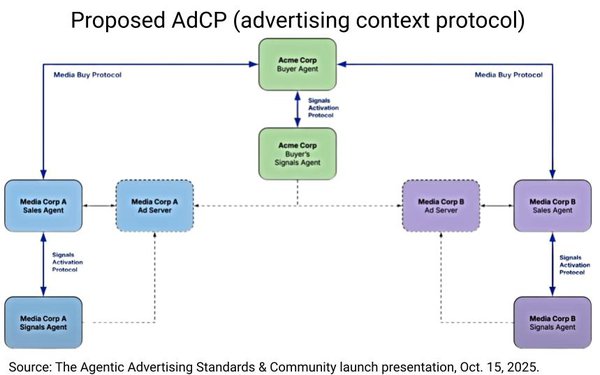
An ad-technology consortium with more than 20
companies is laying the groundwork for the next evolution of automated advertising known as agentic across the open web.
Yahoo, PubMatic, Optable, Scope3, Swivel and Triton Digital are
the founding members of the "Ad Context Protocol (AdCP)," an open technology protocol launched today to standardize how AI agents communicate with one another and carry out tasks on behalf of
humans.
Many others support the protocol, including The Weather Company, Classify, Magnite, MiQ, LG Ad Solutions, Butler/Till, Raptive, Samba TV, and more.
The code for AdCP went
live Wednesday on Github and is open to the public.
The standard aims to make this new technology more consistent across advertising platforms and allow for interoperability. It is built on
Anthropic's Model Context Protocol, and the initial release includes protocols for Audience Activation, Curation, and Media Buy.
advertisement
advertisement
AdCP at launch includes protocols for audience activation,
helping advertisers to discover and activate audience segments directly from publishers, and media buying, enabling agents to execute and manage campaign line items across platforms. The toolset is
expected to expand as the project evolves.
Emma Mulitz, lead engineer and cofounder of Scope 3, and Joseph Hirsch, CEO at Swivel, demonstrated the first live agentic media buy on Wednesday,
showing how companies would carry out the process with human intervention to approve the purchase.
Mulitz provided details on how an agent on behalf of the media buyer and brand communicated
with the Swivel agent to determine available products and inventory. It even increased the media buy. In the future the consortium believes the agents will also create the creative.
AdCP
reverses the traditional flow. Rather than publishers auctioning inventory to buyers in real-time, advertiser agents communicate their needs directly to publisher agents, which respond with relevant
inventory and capabilities.
The protocol provides direct access to inventory. Advertisers can access specific publisher audiences and inventory directly without navigating complex
programmatic infrastructure.
Publishers can offer advertising products requested in a brief without being constrained by manual packaging or operational lift.
Rather than auctioning
individual impressions in real-time, agents can transact on audience segments, engagement, or other value metrics that align buyer-seller incentives.
By eliminating the need to auction every
impression in real-time, AdCP removes layers of intermediaries and dramatically reduces the computational overhead of current systems.
The idea of the protocol is that it directly communicates
and establishes clear accountability and economics between advertisers and publishers.